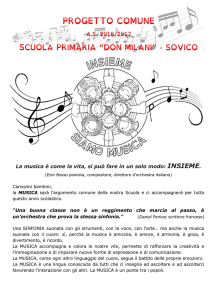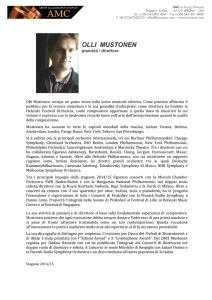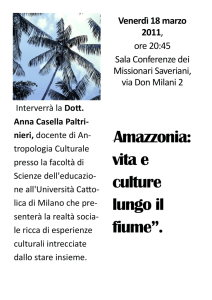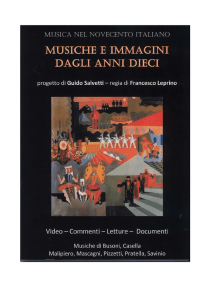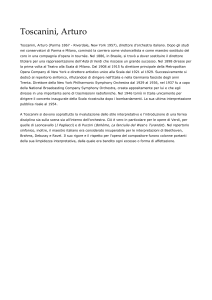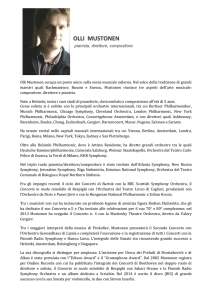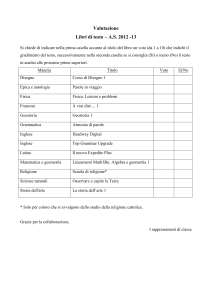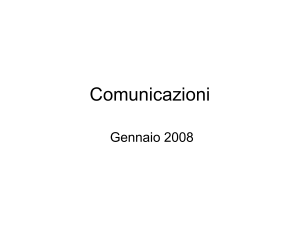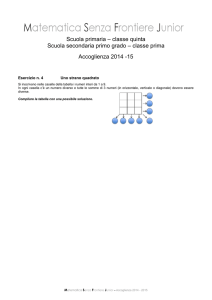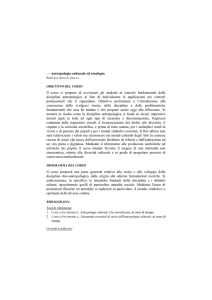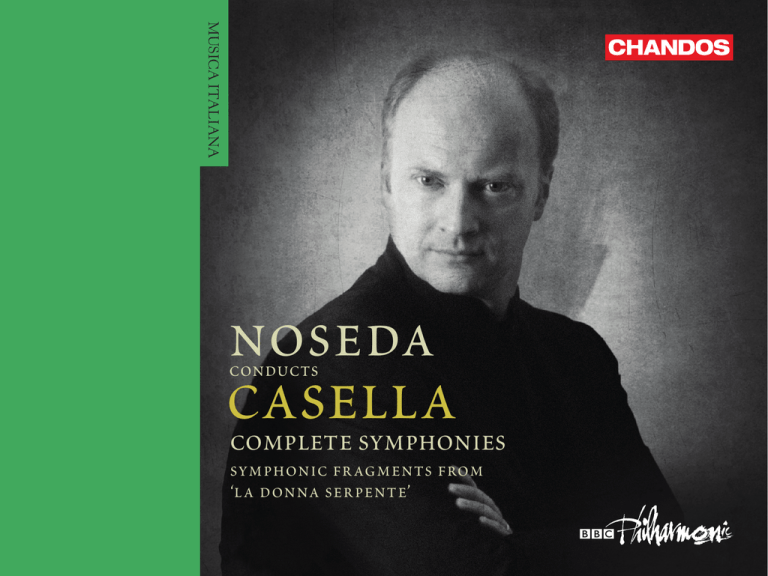
MUSICA ITALIANA
noseda
conducts
CaSella
complete symphonies
symphonic fragments from
‘la donna serpente’
Private collection of Fulvia Casella, reproduced with kind permission
Alfredo Casella, Paris, 1915, in a photograph inscribed to his future wife, then
his pupil
Alfredo Casella (1883 – 1947)
COMPACT DISC ONE
Symphony No. 1, Op. 5 (1905 – 06)
37:59
in B minor • in si minore
1 I
Lento, grave – Più mosso – Tempo I, un poco mosso –
Allegro vivo – Più animato – Lento –
Tempo I – Allegro più moderato – Lento maestoso –
Tempo I (Allegro vivo) – Più animato –
Allegro molto moderato – Più mosso –
Lento, grave – Allegro vivo alla breve
II Adagio, quasi Andante
3 III Lento molto – Poco più mosso –
4 Finale. Allegro vivo, energico
2
10:35
9:57
5:49
11:26
3
Sinfonia, Op. 63 (1939 – 40)
41:55
for Orchestra
(Symphony No. 3)
5 I Allegro mosso – Calmato; tranquillo
9:57
6 II Andante molto moderato, quasi Adagio – Lievemente più mosso –
Calmato, nuovamente sereno
12:11
7 IIIScherzo
Minore. Allegro alquanto pesante e sempre molto ritmico –
Senza affrettare –
Maggiore. Allegro giocoso ed animato –
Variazione. Sempre piano e leggero – Sempre molto piano
7:17
8 IV Rondo Finale. Allegro molto vivace ed animato – Sempre più forte –
Grazioso e leggero – Scherzando grazioso –
Senza affrettare molto vigoroso e sempre ritmico –
Grazioso e leggero – Animando – Andante molto moderato –
Ancora meno andante, quasi Adagio –
Ancora un poco più lento – Lento molto –
Tempo I, animatissimo – Festoso e luminoso
12:13
TT 80:10
4
COMPACT DISC TWO
Symphonic Fragments from ‘La donna serpente’,
Op. 50 (1928 – 31)
1 2 3 26:16
First Series
(9:30)
A Fritz Reiner
Musica del sogno di re Altidòr. Andante (Tempo di Berceuse) –
2:53
Interludio. Andante moderato –
1:22
Marcia guerriera. Tempo di marcia (piuttosto vivace ma non troppo) –
Sempre più forte, ma senza stringere – Crescendo di nuovo e molto –
Sempre più forte – Grandioso – Un poco allargato – A tempo –
Più mosso, ma sempre Largo – Animando sempre più – Allargando –
Doppio tempo – Largamente molto
5:15
Second Series
A Bernardino Molinari
4 Sinfonia. Allegro vivacissimo – Pochissimo meno mosso –
Riprendendo – Di nuovo vivacissimo – Animatissimo –
Sempre più fortissimo ed animato – Fortissimo e giocoso –
Calmando poco a poco – Ancora cedendo –
Meno mosso, ma sempre Vivace – Riprendendo e rianimando –
Cedendo – A tempo –
Vivacissimo, e fino alla fine sempre più animato –
Sempre più animando – Animatissimo e chiassoso –
Senza rallentare!
(16:40)
5:25
5
5
6
Preludio. Lento, ma non troppo – Sempre più fortissimo
Battaglia e Finale. Allegro vivacissimo – Sempre fortissimo –
Largamente – Di nuovo vivacissimo – Sempre animatissimo –
Largamente, pesante –
Finale. Tempo di marcia
6:46
4:22
premiere recording
Symphony No. 2, Op. 12 (1908 – 10)
49:20
in C minor • in do minore
7 I
for Large Orchestra
A G. Enesco
Lento, grave, solenne – Allegro energico –
Assai più lento (quasi Andante calmo) – (Allegro moderato assai) –
Lento (Tempo dell’introduzione) – Tempo I (Allegro energico) –
Animando – Allegro assai vivace – Con tutta la forza –
Tempo I (Allegro energico) – Animato –
Assai più lento (quasi Andante calmo) –
A tempo più mosso (Tempo del Secondo Tema) –
Lento (Tempo dell’introduzione) –
Allegro mosso. Stringendo progressivamente sino alla fine –
Crescendo molto – Presto risoluto
12:29
8 II Allegro molto vivace – Pesante – Furioso –
Maggiore. Più allegro – D.C. al principio
6
8:41
9 III Adagio, quasi Andante –
Animando poco a poco ed appassionando sempre più –
Allargando – Adagio – Tempo del principio
10:48
10 IV Finale. Tempo di marcia ben risoluto, con fuoco –
Feroce. Con energia selvaggia, brutale –
Allegro vivo (alla breve) – Il doppio più lento –
Ancora più lento. Come una marcia funebre – Lento –
Tempo I (Allegro risoluto) – Poco a poco stringendo –
Vivamente – Stringendo improvvisamente e molto –
Allargando molto – Accelerando febbrilmente –
Tempo I, un poco largamente – Stringendo molto – Feroce –
Alla breve, e stringendo sempre inesorabilmente – Disperato –
Allegro molto vivace – Rallentando poco a poco –
Il doppio più lento. Di nuovo a tempo di marcia funebre –
Lento –
10:51
11 Epilogo. Adagio mistico. Con tutta l’intensità di espressione possibile –
Poco a poco crescendo – Appassionatissimo – Largamente –
Maestoso. Trionfale. Con tutta l’energia sino alla fine
6:12
TT 75:53
BBC Philharmonic
Yuri Torchinsky leader
Gianandrea Noseda
7
© Ivano Buat
Gianandrea Noseda
Jan Chlebik
Gianandrea Noseda, with the BBC Philharmonic
Casella:
Symphonies / Symphonic Fragments from ‘La donna serpente’
Symphony No. 1 in B minor, Op. 5
One of the many musical gifts enjoyed by
Alfredo Casella (1883 – 1947) was his ability to
identify the essential characteristics of the
styles of other composers and imitate them
with uncanny accuracy. In some cases he
did it for amusement, as in his pastiche piano
pieces À la manière de... (In the Manner of...).
In other cases, as in his first two symphonies,
he would embrace an alien style with such
passion as to create a major work under its
influence.
His stylistic gift was particularly valuable
when after nearly twenty years in Paris – where
he had studied at the Conservatoire from the
age of thirteen and become one of the most
sophisticated musicians in the city – Casella
returned to Italy to teach at the Liceo di Santa
Cecilia in Rome. He made it his mission there
to rescue younger Italian composers from the
tyranny of the opera house and to ‘restore an
instrumental tradition which had been extinct
for more than a century’ – although in helping
his countrymen find a style, it has often
been said, he had difficulty in finding one
for himself. The charge of eclecticism would
follow him for the rest of his career.
10
Casella began the First Symphony in
Paris and completed it in Piedmont in 1906,
where he liked to spend his summers. It was
published in the same year, which no doubt
pleased the young composer at the time but
which, he recognised later, was ‘all too soon’.
When he conducted the first performance,
in Monte Carlo, a few years later, in 1908, he
realised that he still had much to learn. He
was, however, too hard on himself when he
dismissed a work of such creative energy
and burning conviction as ‘very juvenile’.
At least the central slow movement must
have pleased him as, with little revision
apart from enlarging the orchestration and
adding the date of 1908 on the last page, he
used it again as the third movement of the
Second Symphony. Perhaps he had come
to the conclusion that this Mahlerian Adagio
was stylistically better suited to the Second
Symphony than to its predecessor, the first
movement of which is closer to Moscow and
St Petersburg than Vienna.
Casella developed an enthusiasm for
Russian music, which was stimulated in
the first place not by Diaghilev’s season
of Russian music in Paris in 1907 but by
his friendship with Ravel, a fellow student
in Fauré’s composition class at the
Conservatoire, who had himself fallen in
love with Russian music in the concerts
conducted by Rimsky-Korsakov at the
Exposition Universelle in 1889. They no doubt
amused themselves playing piano-duet
arrangements of music by their favourite
Russians – Balakirev, Borodin, Mussorgsky,
Rimsky-Korsakov... Certainly, with
characteristic stylistic insight Casella had
absorbed much of the Russian nationalist
manner by the time he came to write his First
Symphony.
Mussorgsky is there from the start, in
the sombre theme introduced by cellos
and basses in the opening bars. Neither
that theme nor the quicker companion
idea that follows on woodwind is allowed
to dominate the movement in spite of their
many appearances in a variety of tempi,
melodic shapes, and instrumental colours.
As the tempo slows to Lento a new theme is
heard, rising and falling in chromatic steps
on trumpet and horn over swirling string
arpeggios. Though displaced at an early
stage in the development by the main theme
on bassoons and violas, that second subject
provokes the first full-scale climax. It is
displaced again by the main theme on the
whole orchestra in a broad Lento maestoso.
The last climax (fff) before the short coda,
however, elevates the second subject on
trumpets and horns, its syncopated rhythms
straightened out to clarify its now vividly
projected line.
Framed by a woodwind chorale
harmonised in alien fourths over an ominous
timpani ostinato, the F sharp minor Adagio
seems at this stage to be in a desolate
world of its own. Its main theme, introduced
by oboe and violins, is plainly Mahlerian
rather than Russian in inspiration but
is no less gloomily expressive for that.
Although the key changes to A major for
the soothing second theme, on violins,
there is no lasting consolation. The main
theme is recalled on cor anglais, ruefully
contemplated by solo violin, and carried to
a searing climax (characteristically marked
appassionatissimo) on an extraordinarily
mixed textural accretion of wind and harp
figuration over the pounding timpani rhythm
from the introduction.
The opening section of the third
movement, in which slow and quicker tempi
alternate in an increasingly suspenseful
exchange, is not itself part of the Finale but
a transition to it. The brooding melody of the
slow episodes, introduced by muted cellos
and basses, is clearly intended as a reminder
of the main theme of the first movement.
11
On each of its subsequent appearances,
between mysteriously undulating quicker
passages, it changes shape, assuming on
a solo trumpet and then a solo horn the
character of a fanfare which eventually, after
a brilliant cadenza on violins and a change
of tempo to Allegro vivo, is presented by
trombones as the main theme of the Finale.
Forgetting his Russian allegiance, Casella
now calls on Wagner and Richard Strauss
for inspiration in developing and glorifying
his melodic material in a masterfully
sustained transfiguration. He finally defies
expectations, however, by avoiding a heroic
climax and recalling the opening theme of
the first movement on a thoughtful solo cello
before a quietly radiant ending in B major.
Symphony No. 2 in C minor, Op. 12
Italian composers in the early years of the
twentieth century were not much interested
in the symphony. Alfredo Casella, however,
was a major exception. On the advice of
Giuseppe Martucci – one of the very few
of his generation who had successfully
resisted the prevailing ‘tyranny of opera’
to concentrate on orchestral and chamber
music – the thirteen-year-old Casella had
been sent by his musically ambitious family
in Turin to the Paris Conservatoire. There,
alongside such outstanding fellow students
12
as Maurice Ravel and George Enescu, he had
received the all-round professional training
that would not have been available to him
in Italy.
This did not, of course, translate Casella
into a French composer. Certainly, he was
much influenced in his early piano pieces
not only by his composition teacher, Gabriel
Fauré, but also by Debussy and Ravel. His
next stylistic allegiance, with the Russian
Nationalists – which became inescapably
apparent when he conducted his First
Symphony in B minor in Monte Carlo in
1908 – was also a product of his Parisian
environment, not least by way of a formative
friendship with Ravel. But in his passion for
the music of Gustav Mahler he was, in French
circles at least, more or less on his own. As
Mahler was moved to learn when he first met
Casella, in Paris in 1909, the young composer
knew his symphonies ‘by heart’. It was largely
through heroic efforts on Casella’s part that
Mahler was enabled to conduct one of his
own works – the ‘Resurrection’ Symphony, in
the Théâtre du Châtelet on 17 April 1910 – for
the first and only time in the French capital.
Six days later Casella’s own Second
Symphony in C minor for large orchestra
was first performed in the Salle Gaveau.
Those members of the Paris audience who
were at both events – including perhaps
the dedicatee of the new work, George
Enescu – cannot have failed to notice certain
similarities between the two symphonies.
The Mahlerian aspect of Casella’s score
should not, however, be exaggerated. While
many examples of themes, harmonic colours,
and orchestral sounds derive directly from
the music of Casella’s current hero figure, no
one who knows the two composers could
ever mistake one for the other. Casella has
his own distinctive personality and his own
agenda here. He is more excitable even than
Mahler, unable (except in the uncharacteristic
second movement) to remain in the same
tempo for more than a few bars at once, more
likely to allow his textures to proliferate into
extravagant complexity, more inclined to
drive passion into frenzy.
The first movement of the Second
Symphony begins, like the other three, with
a rhythmic ostinato, this one loaded with
C minor foreboding. Another prominent
feature of the Lento introduction, following
eerie bell sounds, is a heavily emphasised
rhythmic figure – just two notes with a tiny
rest between them – which is to motivate
much of what follows. On a crescendo in
the strings it acts as a springboard into the
first subject of the Allegro energico, in which
it is not only incorporated into the busy
figuration of the violins but also thrust into
the foreground by brass and woodwind, most
memorably where it is transformed into a
Valkyrie-like trumpet call. The second subject
is a contrastingly lyrical melody (beginning
with the ‘Dies Irae’ motif) tenderly presented
in E flat major by violins, at a slower tempo.
The Lento introduction reappears twice: it
precedes a dramatic development section,
devoted largely to first-subject material,
and a full-scale recapitulation in which the
second subject is now heard in C major.
Although the last recall of the Lento is
also in C major, a progressively quicker
and louder coda, surmounted by a huge
climax, dismisses major key aspirations as
unrealistic.
The Allegro molto vivace scherzo in
C minor, which must have been written a
couple of years before the rest of the work,
is something of an anomaly in this context.
The driving ostinato rhythm at the beginning
suggests that Casella might be reverting
to Italian type with a tarantella. In fact the
background here, as in the First Symphony,
is Russian – which becomes clear first at
the entry of the brass fanfares and later at
the introduction of an exotic element in the
delightfully tuneful C major middle section.
For the third movement, Casella salvaged
the slow central movement of his First
Symphony, with which, as a whole, he had
13
grown dissatisfied. Framed by a woodwind
chorale harmonised in alien fourths over
an ominous timpani ostinato, this F sharp
minor Adagio seems at the present stage
to be in a desolate world of its own. Its
main theme, introduced by oboe and
violins, is obviously Mahlerian in inspiration
but no less gloomily expressive for that.
Although the key changes to A major for
the soothing second theme, on violins,
there is no lasting consolation. The main
theme is recalled on cor anglais, ruefully
contemplated by solo violin, and carried to
a searing climax (characteristically marked
appassionatissimo) on an extraordinarily
mixed textural accretion of wind and harp
figuration over the pounding timpani rhythm
from the introduction.
Up to the point at which it dies away to
make room for the Epilogo, the Finale could
have been the last part of what is described
on the manuscript title page of the work,
cancelled but still legible, as a ‘Prologue
for a tragedy’. After setting off as a brisk
Mahlerian march in C minor, it exceeds its
model in grotesquerie, touching on extremes
of brutality, before it encounters another
Mahlerian situation, a funeral oration
delivered in F minor by trombone and tuba
and eliciting sighing sevenths on oboe and
violins. As this happens twice, the second
14
experience more desperate than the first,
there is surely no hope.
With the Epilogo, which follows after a
short pause, everything changes – as the
quotation from Dante’s ‘Purgatorio’ at the
head of it promises:
Per correr miglior acque alza le vele
omai la navicella del mio ingegno,
che lascia dietro a sé mar sì crudele...
(To run over better waters the little vessel
of my genius hoists its sail
to leave behind a sea so cruel...)
In a mystic atmosphere, created in part by the
entry of the organ, first violins reintroduce
the soothing melody from the Adagio. Now
at last it fulfils its consolatory function.
Recalling material from the Lento introduction
to the work, as well as the Valkyrie theme
from the first movement, this time on two
solo horns, it leads the way, ‘with all possible
intensity of expression’, to a sustained and
massively jubilant confirmation of C major. It
is an astonishing achievement – technically
and emotionally overwrought though it may
be – for a composer still in his twenties.
Sinfonia (Symphony No. 3), Op. 63
Alfredo Casella spent his formative years as a
composer not in Italy, where he was born, but
in France. Already an accomplished pianist,
he left Turin at the age of thirteen to complete
his education at the Paris Conservatoire,
studying piano with Louis Diémer and then
composition with Gabriel Fauré. Rather
than going back to Italy when he left the
Conservatoire in 1902, he stayed in Paris until
1915, absorbing influences from whatever
was most vital in European music at the time.
That much is clear from a First Symphony
owing more than a little to the Russian
nationalists, and a particularly interesting
Second Symphony inspired by a passion for
the music of Gustav Mahler.
By the time Casella came to write the
Third Symphony, commissioned by Frederick
Stock to celebrate the fiftieth anniversary of
the Chicago Symphony Orchestra, his music
had achieved a classical poise quite unlike
the turbulence of that of his Paris period.
Working on it a year into the Second World
War, the composer might have been inspired
to bring it to its triumphant conclusion by
his misguided faith (along with that of most
patriotic Italians at the time) in the political
and military leadership of Mussolini.
Much of the thematic interest of the
first movement is derived from the pastoral
melody introduced in A minor by a solo oboe
in the opening bars. This changes radically
in character as it passes from one group of
instruments to another, until it gives way, on
a diminuendo, to the more song-like second
subject in D flat major on oboes and violas.
This theme, too, is enterprisingly varied in
character and colour. But, beginning low on
cellos, the development is dominated by the
first subject – to such an extent that, after
the fff climax of the movement, the second
subject is recapitulated first, on horn, in
A major. The formal recall of the main theme
is held in reserve for the oboe, back in A minor,
shortly before the evanescent ending.
While the oboe melody from the opening
Allegro is not literally quoted in the slow
movement, there are frequent echoes of
it – not so much in the tonally uncertain
introduction, in which a solo violin mingles
with woodwind, as in the romantic, almost
Mahlerian melody presented by first violins
as the harmonies settle in E major. The
expressive beauty of the episode that
follows, sustained by remarkable linear
flexibility and imaginative counterpoint,
encounters a sinister off-beat marching
rhythm, which unstoppably approaches a
violent climax. Calm is restored, though not
without an inimically articulated threat from
trombones, and lasts until the opening bars
are quietly recalled – now with reminders of
the oboe melody, before the E major close.
The Scherzo is divided into three main
sections, headed Minore (in G minor),
15
Maggiore (in G major) and Variazione,
respectively. The first is distinctly warlike
(not to say Shostakovich-like) in its heavy
repetitive rhythms, its woodwind shrieks,
and brass outcries. The festive second
section is based on authentically lighthearted scherzo material. Even more
resourcefully orchestrated, Variazione,
though ending in G minor, brilliantly
reconciles the two.
The main theme of the Rondo Finale
(in C major) takes shape only gradually,
appearing first as a propulsive rhythmic
ostinato on cellos and then on brass. It
bursts out in its definitive form on the crest
of a crescendo on the four horns. Although
this rondo theme alludes to the seminal
melody from the first movement, it is only
when its considerable energy is exhausted
that the oboe melody is heard in its original
form, in A minor. Energy is restored, first in
combination with the oboe theme and then,
with extraordinary vitality, in a progression
towards the most dynamic climax in the
whole work – which is suddenly silenced. A
slow epilogue recalls the Mahlerian theme
of the Andante as well as the oboe melody,
now on cor anglais in C major. With another
sudden change of mood, the rondo theme
briefly returns to celebrate a triumphant
ending.
16
Symphonic Fragments from ‘La donna
serpente’, Op. 50
An outstandingly interesting composer in
every respect – not least for his abundant
creativity and rare technical skill – Alfredo
Casella is particularly fascinating for the way
in which his development paralleled the great
movements in twentieth-century musical
history. Although he was born in Italy and
spent his early years there, the formative
experience of his youth was his training at
the Paris Conservatoire and his exposure to
the French impressionist idiom. But, as we
know from his early orchestral scores, the
overwhelming passion of his mid-twenties
was for late-romantic music, above all that of
Gustav Mahler, whose example was largely
responsible for the remarkable Second
Symphony. Like the romantic movement
itself, however, that passion could not last
and, again, like music itself, he found himself
in a period of experimentation. He followed
the progressive initiatives of Stravinsky and
Schoenberg, not stopping short at atonalism
but without adopting serialism: by the time
Schoenberg formulated his twelve-note
system Casella had moved on again.
Unlike most Italian composers of his
generation, Casella had no operatic ambitions
in the early part of his career. It was not until
after his return to Italy from Paris in 1915 that
he began to take a creative interest in the
theatre. He was particularly attracted to the
work of Carlo Gozzi, author of the dramatic
fables that furnished the libretti of Prokofiev’s
Love for Three Oranges and Puccini’s Turandot.
His own favourite was La donna serpente
(The Serpent Woman), not because it was the
source of Wagner’s early opera Die Feen –
Casella, now in his neoclassical phase, had no
desire to emulate Wagner – but because, he
said, ‘it would permit me to attempt a work of
similar type to Mozart’s Zauberflöte’. In fact,
La donna serpente has much in common with
Die Zauberflöte, including the magic and comic
elements, as well as the heroic rescue of a
beautiful young woman, in this case a halffairy queen condemned to assume the shape
of a serpent for 200 years.
Fortunately, to appreciate the Symphonic
Fragments, extracted from the opera by the
composer soon after its first, short run in
1932, it is not necessary to be aware of the
intricate details of the plot. The First Series
begins with music that accompanies the
dream of King Altidòr in the first act, before
the misfortune that is to befall him and his
Queen, Miranda. One of the most lyrical
elements in the score, it takes the form of a
cradlesong, the rocking motion initiated by
two muted cellos before the oboe introduces
an appropriately sleepy melody. The next
extract, which follows without a break, is the
short ‘Interludio’ from the second act, tense
with distant trumpet calls and nervous cellos
and basses. It leads, again without a break,
into the ‘Marcia guerriera’, Casella’s colourful
equivalent of Prokofiev’s March in The Love for
Three Oranges.
The Second Series of extracts from
La donna serpente begins with the ‘Sinfonia’,
or Overture, to the opera. In the theatre it
follows a lengthy prologue but here it bursts
immediately into tuneful life. The ‘Preludio’
before the third (and last) act reflects the
dire situation in which Altidòr and his Queen
find themselves before he heroically rescues
Miranda from her fate. Opening and closing
with mournful muted horns and bassoon,
it builds to a climax of tragic proportions.
Salvation comes by way of the brisk, fiercely
brilliant music of the ‘Battaglia’ (Battle) and
is celebrated in a Finale adapted from the
triumphant choral march, ‘Gioia’ (Joy), which
concludes the opera.
© Gerald Larner
Why rediscover Casella?
Mainly because of the sheer quality of his
compositions, which win over audiences
after their initial puzzlement – ‘Casella, who
is he?’
17
Because of the life-long dedication with
which he promoted the works of colleagues
whom he respected. We should not forget
that he maintained very friendly relations
with Igor Stravinsky, Maurice Ravel, and many
other artists working in the early twentieth
century.
Because of the internationalism evident
throughout his activity as a concert pianist
and chamber musician, as well as during
his spell as principal conductor of the Boston
Pops for two seasons, from 1927 to 1929.
Because of the insatiable curiosity that led
him to appreciate new and little-known forms
such as jazz and all the varieties of music
of the Afro-Americans, which became the
innovative core of the compositions of the
1920s and ’30s in America.
Because of his gifts as a teacher who
inspired younger generations of musicians by
producing critical editions of masterpieces
of the piano repertoire, such as Beethoven’s
thirty-two piano sonatas.
As this brief list of motivating factors
demonstrates, Casella was an outstanding
musician who fortunately left us many works
of the highest quality, which deserve a regular
place in the seasonal programmes of theatres
and concert halls all over the world.
If, however, I have to admit to the real
reason why I conduct the music of Casella, it
18
is simply and solely the great pleasure it gives
me and which I hope can be communicated to
those people willing to listen to it.
© 2016 Gianandrea Noseda
Translation: Avril Bardoni
A broadcasting orchestra based in Salford,
the BBC Philharmonic performs at the
Bridgewater Hall, Manchester, tours the North
of England, and welcomes audiences in its
recording studio at MediaCityUK. It gives more
than a hundred concerts each year, nearly all
of which are broadcast on BBC Radio 3,
the BBC’s home of classical music. It also
appears annually at the BBC Proms. Champion
of British composers, the orchestra works with
world-class artists from a range of genres and
styles, and in 2014 revived BBC Philharmonic
Presents, a series of collaborations across
BBC Radio stations, showcasing its versatility
and adventurous, creative spirit. It is
supported by Salford City Council, which
enables a busy, burgeoning Learning and
Outreach programme within schools and
the local community. Working closely with
the Council and other partners, including
the Royal Northern College of Music, Salford
University, and Greater Manchester Music
Hub, it supports and nurtures emerging talent
from across the North West.
The BBC Philharmonic is led by its Chief
Conductor, Juanjo Mena, whose love of largescale choral works and the music of his home
country, Spain, has produced unforgettable
performances in the concert hall and on disc.
Its Principal Guest Conductor, John Storgårds,
recorded a Sibelius symphony cycle with the
orchestra in 2013 to much critical acclaim.
The distinguished Austrian HK ‘Nali’ Gruber is
Composer / Conductor and led the orchestra in
a residency at the Wiener Konzerthaus in 2013.
Its former principal conductors Gianandrea
Noseda and Yan Pascal Tortelier also return
regularly. Internationally renowned, it frequently
travels to the continent and Asia, where the
dates which had been cancelled when a tour
of Japan was cut short by the catastrophic
earthquake and tsunami in 2011, were
completed in 2014. Having made more than
250 recordings with Chandos Records and sold
around 900,000 albums, the BBC Philharmonic,
along with the remarkable pianist Jean-Efflam
Bavouzet and conductor Gianandrea Noseda,
won the 2014 Gramophone Concerto Award.
Music Director of the National Symphony
Orchestra in Washington DC and Teatro
Regio Torino, Artistic Director of the Stresa
Festival in Italy, and Principal Guest Conductor
of the Israel Philharmonic Orchestra,
Gianandrea Noseda was at the helm of
the BBC Philharmonic for a decade. He has
appeared all over the world with orchestras
such as the New York Philharmonic, Chicago
Symphony Orchestra, Philadelphia Orchestra,
Pittsburgh Symphony Orchestra, Berlin
Philharmonic Orchestra, Swedish Radio
Symphony Orchestra, Oslo Philharmonic
Orchestra, Deutsches Symphonie-Orchester
Berlin, Orchestre de Paris, and NHK Symphony
Orchestra, Tokyo. At the start of the 2016 / 17
season he will assume the post of Principal
Guest Conductor of the London Symphony
Orchestra, with which an intense collaboration
began in 2008 and has included several
appearances in London and extensive touring
activity in Europe and the US. In 2005, live
performances of Beethoven’s complete
symphonies with the BBC Philharmonic,
offered as part of BBC Radio 3’s The Beethoven
Experience, attracted the historical figure
of 1.4 million download requests. Since
2002 Gianandrea Noseda has been closely
associated with Chandos Records. He has
recorded works by Prokofiev, Karłowicz, Dvořák,
Smetana, Shostakovich, Liszt, Rachmaninoff,
Mahler, Verdi, Rufinatscha, and Bartók. An
extensive survey of the music of Italian
composers of the twentieth century includes
recordings of works by Respighi, Dallapiccola,
Wolf-Ferrari, Petrassi, and Castiglioni, with a
particular focus on Alfredo Casella.
19
Introduction to the Fondazione Giorgio Cini
The Fondazione Giorgio Cini (Giorgio Cini
Foundation) has its seat on the island of San
Giorgio Maggiore in Venice. Established in 1951
by Count Vittorio Cini, a senator and one of
the most important Italian entrepreneurs of
the twentieth century, patron of the arts and
collector, the Foundation was inspired by his
love for his son, tragically killed in an air crash.
The impressive interior of the ancient
Benedictine monastery, incorporating the
monks’ dormitory, refectory, library, novitiate,
cloisters, abbots’ apartments, guest
rooms, and more, is a striking testimonial
to the greatest architects and artists of the
Renaissance and baroque eras. The beautifully
restored building houses Institutes and
Centres of Research devoted to many different
disciplines – visual arts, music, literature,
political and economic history, theatre, oriental
studies – relating to the age-old Venetian
civilisation.
20
Their research activities, conferences and
seminars, publications, exhibitions, concerts
and performances persist to the present day
and are being expanded on a global scale.
The work is facilitated by state-of-the-art
tools: libraries and photographic, press, and
microfilm archives which have expanded in
time and now constitute a unique scientific
and documentary resource.
The Founder also contributed priceless
collections of antiquarian books, drawings,
miniatures, paintings, sculptures, ceramics,
household furnishings, opera libretti,
and musical instruments, all these, too,
supplemented by significant subsequent
donations.
I therefore hold it an honour and a duty to
support initiatives such as this that keep alive
the spirit of the Founder in our time.
© 2016 Giovanni Alliata di Montereale
Grandson of Vittorio Cini
The Istituto per la Musica (Institute of
Music) was established in 1985 as an entity
independent from that of Letters, on the
initiative and under the direction of Giovanni
Morelli. Since 2012 it has been directed by
Gianmario Borio.
The Institute curates invaluable estates
and archives relating to twentieth-century
Italian composers, including Malipiero,
Respighi, Rota, Casella, and Boito.
The Casella archive was entrusted to
the Fondazione Cini on 26 May 1989 by
the composer’s daughter, Fulvia Casella
Nicolodi. The composer’s heirs donated it
on 25 October 2001. The archive comprises
around 23,000 documents, some original,
others photocopied or in photographic form,
organised in six groups: Correspondence,
Writings, Autograph scores, Concert
programmes, Reviews and critical writings,
Photographs.
On 13, 14, and 15 May 1992 the Institute
organised its first Study Conference on
Alfredo Casella, dedicated particularly to his
‘Years of Apprenticeship in Paris’, with the
presentation of the complete Catalogue,
published by Leo S. Olschki Editore in four
volumes in the Fondazione Cini’s series Studi
di Musica Veneta [Studies of Venetian Music].
Later, a further three volumes of Casella
material were published in the same series,
and in 2004 a CD was released of his works
for piano, performed by the duo Eugenio
Bagnoli (his pupil) and Gino Gorini.
Website: www.cini.it
21
Private collection of Fulvia Casella, reproduced with kind permission
Alfredo Casella, Turin, 1896, the piano soloist in his
first orchestral concert
Casella:
Sinfonie / Frammenti Sinfonici da “La donna serpente”
Sinfonia No. 1 in si minore, Op. 5
Una delle molte qualità musicali di Alfredo
Casella (1883 – 1947) era la sua abilità di
identificare le caratteristiche essenziali
degli stili di altri compositori e imitarle con
sbalorditiva precisione. In alcuni casi lo
faceva per divertimento, come nel pastiche
pianistico À la manière de... In altri casi, come
nelle sue prime due sinfonie, abbracciava lo
stile altrui con una tale passione, da saper
creare un’opera di straordinaria individualità
sotto quella influenza.
Questa sua qualità stilistica si rivelò
particolarmente preziosa quando, dopo
quasi vent’anni trascorsi a Parigi – dove
aveva studiato al Conservatorio dall’età
di tredici anni per diventare uno dei più
sofisticati musicisti della città – Casella
rientrò in Italia per insegnare al Liceo di Santa
Cecilia a Roma. Qui si diede per missione
quella di salvare i giovani compositori italiani
dalla tirannia dell’opera per “restaurare una
tradizione strumentale che era estinta da
più di un secolo” – sebbene nell’aiutare i
suoi compatrioti a trovare uno stile, si è
detto spesso, abbia poi avuto problemi a
identificarne uno per sé stesso. L’accusa di
“eclettismo” l’avrebbe in effetti perseguitato
per il resto della sua carriera.
Casella iniziò a comporre la sua Prima
Sinfonia a Parigi e la terminò nel 1906 sulle
colline piemontesi, dove amava passare le
sue estati. Fu pubblicata nello stesso anno,
il che senza dubbio al tempo dovette far
piacere al giovane compositore, che però
ebbe poi a dire “era troppo presto”. Quando,
pochi anni dopo, nel 1908, ne diresse la
prima esecuzione a Monte Carlo, realizzò
che aveva ancora molto da imparare. Fu,
tuttavia, troppo duro con sé stesso nello
scartare un’opera di simile energia creativa e
focosa convinzione come “molto giovanile”.
Almeno il movimento centrale lento doveva
alla fine essergli piaciuto se, con qualche
piccola revisione, e a parte un’orchestrazione
allargata e l’aggiunta della data 1908, lo usò
tale e quale come terzo movimento della sua
Seconda Sinfonia. Forse dovette concludere
che questo Adagio di stampo mahleriano
doveva essere stilisticamente più consono
alla Seconda Sinfonia che alla precedente, il
primo movimento della quale era più vicino
a Mosca e San Pietroburgo che non a
Vienna.
23
Casella aveva sviluppato per la musica
russa un vero entusiasmo, dovuto non tanto
alla Saison Russe parigina di Diaghilev del
1907, quanto alla sua amicizia con Ravel, suo
compagno nella classe di composizione di
Fauré al Conservatorio di Parigi, anche lui
innamoratosi della musica russa ai concerti
diretti da Rimsky-Korsakov per l’Esposizione
Universale del 1889. Senza dubbio si saranno
divertiti suonando gli arrangiamenti per
pianoforte a quattro mani delle musiche dei
loro compositori russi preferiti – Balakirev,
Borodin, Mussorgsky, Rimsky-Korsakov...
Certo, con il suo caratteristico talento,
Casella aveva assorbito molto della maniera
nazionale russa quando arrivò per lui il
momento di scrivere la sua Prima Sinfonia.
Mussorgsky è presente sin dall’inizio,
nel cupo tema introdotto dai violoncelli e
dai contrabbassi nelle battute di apertura.
Ma non sarà questo tema, nè il successivo
più veloce affidato ai legni, che riuscirà a
dominare il primo movimento, nonostante le
ripetute apparizioni in tempi, forme melodiche
e colori strumentali diversi. Non appena il
tempo rallenta verso il Lento un nuovo tema si
manifesta, sale e scende in scale cromatiche
affidate alla tromba e al corno sopra un
vorticoso arpeggiare di archi. Benché
sovrastato all’inizio dello sviluppo dal tema
principale affidato a fagotti e viole, questo
24
secondo soggetto finisce per essere quello
che provoca la prima vera culminazione. Di
nuovo viene dominato dal tema principale,
affidato questa volta a tutta l’orchestra, in un
ampio Lento maestoso. L’ultima culminazione
(fff) prima della breve coda, tuttavia, eleva
ancora il secondo soggetto con trombe e
corni, con un ritmo meno sincopato che
conferisce chiarezza alla sua linea finalmente
limpidamente proiettata.
Incorniciato da un corale dei legni
armonizzato in accordi di quarta su un
infausto ritmo ostinato dei timpani, l’Adagio
in fa diesis minore sembra rappresentare
un desolato mondo a sé. Il suo tema
principale, introdotto dall’oboe e dai violini,
è di ispirazione più mahleriana che russa ma
non certo meno densamente espressivo.
Nonostante la tonalità passi al la maggiore
per il rassicurante secondo tema affidato
ai violini, non c’è consolazione possibile.
Il tema principale è richiamato dal corno
inglese, mestamente contemplato dal violino
solo e portato a una violenta culminazione
(tipicamente indicata con la notazione
appassionatissimo) su un crescendo dalla
testura straordinariamente densa di fiati e
arpe sovrastante il ritmo battente dei timpani
dell’introduzione.
La sezione di apertura del terzo tempo,
nel quale movimenti lenti e più veloci si
alternano in uno scambio sempre più ricco
di suspense, non è in effetti parte del
Finale ma una transazione verso di esso.
La minacciosa melodia degli episodi lenti,
introdotta da violoncelli e contrabbassi con
sordina, è intesa chiaramente come il ricordo
del tema principale del primo movimento. In
ognuna delle sue successive apparizioni,
tra passaggi più rapidi e misteriosamente
ondivaghi cambia forma, assumendo
prima con un solo della tromba e poi del
corno, il carattere di una fanfara che, dopo
una brillante cadenza affidata ai violini e
un cambio di tempo in Allegro vivo, viene
infine presentato dai tromboni come il tema
principale del Finale.
Dimentico della sua lealtà ai russi, Casella
ora si rivolge a Wagner e Richard Strauss
per trarre l’ispirazione nello sviluppare e
glorificare il suo materiale melodico in una
trasfigurazione sostenuta con maestria. Alla
fine, tuttavia, sfida ogni aspettativa evitando
la culminazione eroica e richiamandosi invece
al tema di apertura del primo movimento su
un pensieroso solo del violoncello prima del
calmo e radioso finale in si maggiore.
Sinfonia No. 2 in do minore, Op. 12
I compositori italiani dell’inizio del ventesimo
secolo non erano granchè interessati alla
sinfonia. Alfredo Casella costituì, tuttavia,
una singolare eccezione. Su consiglio di
Giuseppe Martucci – uno dei pochissimi della
sua generazione a resistere con successo
alla prevalente “tirannia dell’opera” per
concentrarsi sulla musica per orchestra
e da camera – il tredicenne Casella era
stato spedito dalla sua famiglia torinese,
musicalmente ambiziosa, al Conservatorio
di Parigi. Qui, insieme a compagni di corso
straordinari come Maurice Ravel e George
Enescu, ricevette un’educazione musicale
a tutto tondo, come non sarebbe stato
possibile in Italia.
Tutto questo non fece di Casella,
naturalmente, un compositore francese.
Indubbiamente nelle sue giovanili
composizioni per pianoforte fu influenzato
non solo dal suo insegnante di composizione,
Gabriel Fauré, ma anche da Debussy e
Ravel. La successiva influenza stilistica dei
nazionalisti russi – che divenne evidente
quando diresse la sua Prima Sinfonia in
si minore a Monte Carlo nel 1908 – era certo il
prodotto dell’ambiente parigino, soprattutto
del suo sodalizio formativo con Ravel. Ma
nella sua passione per la musica di Gustav
Mahler era, almeno nei circoli francesi, più
o meno un solitario. Mahler rimase molto
impressionato nell’apprendere, nel suo primo
incontro con Casella, a Parigi nel 1909, come
il giovane compositore conoscesse le sue
25
sinfonie “a memoria”. E fu largamente grazie
all’eroico sforzo di Casella che Mahler fu in
grado di dirigere uno dei suoi capolavori – la
sinfonia “Resurrezione” al Théâtre du Châtelet
il 17 Aprile 1910 – per la prima e unica volta
nella capitale francese.
Sei giorni più tardi, la Seconda Sinfonia
in do minore per grande orchestra dello
stesso Casella venne eseguita per la prima
volta alla Salle Gaveau. Coloro che, nel
pubblico, ebbero l’opportunità di assistere a
entrambi gli eventi – tra loro probabilmente
il dedicatario della nuova opera, George
Enescu – non poterono evitare di notare certe
similitudini tra le due sinfonie. Non bisogna
tuttavia esagerare l’aspetto mahleriano della
partitura caselliana. Sebbene molti esempi di
temi, colore armonico e sonorità orchestrali
derivino chiaramente dalla musica dell’eroe
del momento per Casella, nessuno che
conosca i due compositori potrebbe prendere
la musica dell’uno per quella dell’altro.
Casella ha qui una sua personalità chiara e
un suo proprio programma. Addirittura più
emotivamente sensibile di Mahler, incapace
(ad eccezione del singolare secondo
movimento) di mantenere lo stesso tempo
per più di poche battute alla volta, più incline
a lasciar proliferare la propria orchestrazione
in una stravagante complessità e a spingere
la passione verso la frenesia.
26
Il primo movimento della Seconda
Sinfonia inizia, come i successivi tre, con
un ritmo ostinato, carico di un profetico
do minore. Altro elemento evidente del Lento
introduttivo, dopo i rintocchi misteriosi delle
campane, è la figurazione ritmica molto
enfatizzata – due semplici note inframezzate
da una piccola pausa – che sembra
determinare quasi tutto quel che segue.
Su un crescendo degli archi essa agisce
come un trampolino verso il primo soggetto
dell’Allegro energico, nel quale è presente
non solo nella densa figurazione dei violini
ma anche nel primo piano rappresentato
da legni e ottoni, in particolare quando si
trasforma in uno squillare di trombe tipo
cavalcata delle valchirie. Il secondo soggetto
è, per contrasto, una melodia lirica (che
inizia con il motivo del “Dies Irae”) presentato
teneramente dai violini in mi bemolle
maggiore, con un tempo più lento. Il Lento
introduttivo riappare due volte: precede uno
sviluppo drammatico, in larga parte dedicato
al materiale del primo soggetto, per poi
espandersi pienamente nella ricapitolazione,
in cui il secondo soggetto si fa ascoltare ora
in do maggiore. Nonostante l’ultimo richiamo
del Lento sia pure in do maggiore, una coda
sempre più veloce e sonora sovrastata da una
imponente culminazione, fa apparire del tutto
irrealistica l’aspirazione alla tonalità maggiore.
Lo scherzo Allegro molto vivace in
do minore, che deve essere stato scritto un
paio d’anni prima del resto dell’opera, appare
come un’anomalia in questo contesto. Il
trainante ritmo ostinato dell’inizio suggerisce
che Casella si stia qui riavvicinando a una
tipologia italiana con una tarantella. Di fatto
il contesto musicale è, come nel caso della
Prima Sinfonia, piuttosto russo – come
appare chiaramente al primo ingresso della
fanfara degli ottoni e più tardi al sorgere di
un elemento esotico nella melodicamente
deliziosa sezione mediana in do maggiore.
Per il terzo movimento, Casella recupera
il movimento lento centrale della sua Prima
Sinfonia, della quale – in complesso – era
rimasto insoddisfatto. Incorniciato da un
corale dei legni armonizzato in accordi di
quarta su un infausto ritmo ostinato dei
timpani, questo Adagio in fa diesis minore
sembra rapprentare un desolato mondo a sé.
Il suo tema principale, introdotto dall’oboe e
dai violini, è di ispirazione mahleriana ma non
per questo meno densamente espressivo.
Nonostante la tonalità passi in la maggiore
per il rassicurante secondo tema, affidato
ai violini, non sembra esserci consolazione
possibile. Il tema principale è richiamato dal
corno inglese, poi mestamente contemplato
dal violino solo e infine portato a una violenta
culminazione (tipicamente indicata con
la notazione appassionatissimo) su un
crescendo dalla testura straordinariamente
mista di fiati e arpe sovrastante il ritmo
battente dei timpani dell’introduzione.
Fino al punto in cui svanisce per
lasciare spazio all’Epilogo, il Finale avrebbe
potuto essere l’ultima parte di quello che
figurava sul frontespizio del Manoscritto
dell’opera, cancellato ma ancora leggibile,
come il “Prologo per una tragedia”. Avviata
una marcia in do minore vivacemente
mahleriana, qui Casella supera il suo modello
in eccesso grottesco, raggiungendo il
culmine della brutalità, prima di sfociare in
un’altra situazione tipicamente mahleriana,
un’orazione funebre presentata in chiave
di fa minore da trombone e tuba, che sfocia
in un sussurro di settime dell’oboe e dei
violini. Dato che questa situazione si ripete
due volte, la seconda in maniera ancora più
disperata della prima, sembra proprio non
esserci speranza alcuna.
Con l’Epilogo, che segue dopo una breve
pausa, tutto cambia – come la citazione dal
“Purgatorio” di Dante nella sua testata ci
promette:
Per correr miglior acque alza le vele
omai la navicella del mio ingegno,
che lascia dietro a sé mar sì crudele...
In una mistica atmosfera, creata in parte
dall’ingresso dell’organo, i primi violini
27
introducono nuovamente la rassicurante
melodia dell’Adagio. Ora, finalmente, essa
può compiere la sua funzione pienamente
consolatrice. Richiamando il materiale del
Lento che introduceva l’opera, come pure
il tema valchiriano del primo movimento,
questa volta con due corni solisti, apre la
strada “con tutta l’intensità di espressione
possibile” a una sostenuta e massiccia
riaffermazione della giubilante tonalità di
do maggiore. Una conquista stupefacente –
dal punto di vista tecnico ed emotivo e per
quando eccessivamente elaborata essa sia –
per un compositore appena ventenne.
Sinfonia (Sinfonia No. 3), Op. 63
Alfredo Casella aveva trascorso i suoi
anni di formazione da compositore, come
abbiamo visto, non in Italia, dove era nato,
ma in Francia. Già pianista compiuto, aveva
infatti lasciato Torino all’età di tredici
anni per completare la sua educazione
al Conservatorio di Parigi, per studiarvi
pianoforte con Louis Diémer e composizione
con Gabriel Fauré. Invece di tornare in Italia
una volta lasciato il Conservatorio nel 1902,
rimase a Parigi fino al 1915, assorbendo
l’influenza di quanto di più vivace ci fosse
nella musica europea di quel tempo. Tanto
è chiaro nella sua Prima Sinfonia, che
deve molto ai nazionalisti russi, quanto
28
particolarmente interessante nella sua
Seconda Sinfonia, ispirata dalla fervente
passione per la musica di Gustav Mahler.
Al momento di comporre la sua Terza
Sinfonia, commissionata da Frederick
Stock per celebrare il cinquantesimo
anniversario della fondazione della Chicago
Symphony Orchestra, la musica di Casella
aveva raggiunto una postura più classica,
diversamente dalle turbolenze del periodo
parigino. Lavorandovi nel primo anno di
guerra per l’Italia, il compositore potrebbe
essere stato ispirato a indirizzarsi verso la
trionfante conclusione dall’illusoria fiducia
(condivisa con la maggioranza dei patrioti
italiani del tempo) nella leadership politica e
militare di Mussolini.
Molto dell’interesse tematico del primo
movimento deriva dalla melodia pastorale
in la minore introdotta dall’oboe solista nelle
battute introduttive della sinfonia. Questa
atmosfera muta radicalmente di carattere nel
passaggio da una famiglia strumentale all’altra,
fino a lasciare il posto – su un diminuendo – al
secondo soggetto in re bemolle maggiore
in forma di canzone, affidato agli oboi e alle
viole. Anche questo tema subisce variazioni,
per carattere e colore, in maniera alquanto
intraprendente. Ma, dopo un inizio grave
affidato ai violoncelli, lo sviluppo risulta
dominato dal primo soggetto al punto
tale, che dopo la culminazione in fff del
movimento, il secondo soggetto finisce per
essere ricapitolato in la maggiore dal corno. Il
richiamo formale del tema è riservato all’oboe,
di nuovo in tonalità di la minore, subito prima
dell’evanescente finale.
Sebbene la melodia dell’oboe dall’Allegro
iniziale non sia citata letteralmente nel
movimento lento, se ne ritrovano echi
frequenti – non tanto nell’introduzione dalla
tonalità incerta, in cui un violino solo si
confonde con i legni, quanto nella romantica,
e quali mahleriana melodia presentata dai
primi violini non appena l’armonia si ferma
sulla tonalità di mi maggiore. La bellezza
espressiva dell’episodio seguente, sostenuta
da una notevole flessibilità della linea
melodica e da un fantasioso contrappunto,
si incontra con un sinistro ritmo di
marcia in controtempo, che si avvicina
inarrestabilmente alla violenta culminazione.
Alla fine torna la calma, non senza una
pericolosamente articolata minaccia dei
tromboni, che dura fino a quando le battute
iniziali sono placidamente richiamate dalla
melodia dell’oboe, prima della chiusa in
mi maggiore.
Lo Scherzo è diviso in tre sezioni
principali, rispettivamente intitolate Minore
(in sol minore), Maggiore (in sol maggiore)
e Variazione. La prima è decisamente
militaresca (per non dire alla Šostakovič)
nel suo ritmo ripetitivo e pesante, nello
stridere dei legni come nell’urlo degli ottoni.
La festosa seconda sezione è basata su un
autenticamente ironico materiale tipico dello
“Scherzo”. Grazie alla sua orchestrazione
se possibile ancora più ricca, la Variazione,
sebbene termini in sol minore, riconcilia
brillantemente le due sezioni precedenti.
Il tema principale del Rondo Finale (in
do maggiore) prende forma solo gradualmente,
con l’apparire di una propulsione ritmica
ostinata, affidata prima ai violoncelli e poi
agli ottoni, per esplodere nella sua forma
definitiva sulla sommità di un crescendo dei
quattro corni. Seppur questo tema di rondò
alluda alla melodia fondamentale del primo
movimento, è solo con l’esaurirsi della sua
prepotente energia che la melodia dell’oboe
si fa udire nella sua forma originale e nella
tonalità di la minore. L’energia è ritrovata,
prima con il tema dell’oboe e poi, con vitalità
straordinaria, in una progressione che porta
alla culminazione più dinamica di tutta
l’opera – improvvisamente ridotta al silenzio.
Un lento epilogo richiama il tema mahleriano
dell’Andante come pure la melodia dell’oboe,
ora affidata al corno inglese in do maggiore.
Con un nuovo e improvviso cambio di umore,
il tema di rondò ritorna brevemente per
celebrare il trionfante finale.
29
Frammenti sinfonici da ‘La donna serpente’,
Op. 50
Compositore straordinariamente
interessante da tutti i punti di vista –
non ultimo per faconda creatività e per
rare capacità tecniche – Alfredo Casella
risulta particolarmente affascinante per il
modo in cui il suo sviluppo personale si è
accompagnato ai grandi movimenti della
storia musicale del ventesimo secolo.
Benchè fosse nato in Italia, dove spese i
primi anni di vita, l’esperienza formativa
fondamentale della sua giovinezza fu la
sua frequentazione del Conservatorio di
Parigi e la sua esposizione al linguaggio
dell’impressionismo francese. D’altra parte,
come abbiamo visto nei suoi giovanili lavori
orchestrali, la travolgente passione dei suoi
vent’anni fu per la musica tardo-romantica,
in particolare per quella di Gustav Mahler, il
cui esempio fu largamente responsabile dei
notevoli esiti della sua Seconda Sinfonia.
Come per lo stesso movimento romantico,
tuttavia, questa passione travolgente non
era destinata a durare e di nuovo, come per la
musica, anche Casella si trovò ad affrontare
una fase di sperimentazione. Seguì allora
le iniziative progressiste di Stravinsky e
Schoenberg, non rifiutando l’atonalismo
ma senza adottare il serialismo: e prima
che Schoenberg formulasse la sua teoria
30
dodecafonica, Casella si era già mosso in
un’altra direzione.
Diversamente da pressochè tutti i
compositori italiani della sua generazione,
Casella non ebbe ambizioni di operista nella
prima fase della sua carriera. Fu solo dopo il
suo rientro in Italia da Parigi nel 1915 che iniziò
a interessarsi al teatro, attratto in particolare
dal lavoro di Carlo Gozzi, autore di favole
drammatiche che avevano fornito libretti di
successo per opere come L’amore delle tre
melarance di Prokof’ev e la Turandot di Puccini.
La sua favorita era La donna serpente, non
certo perché fosse stata la fonte dell’opera
giovanile di Wagner Die Feen – Casella, ora
nella sua fase neoclassica, non aveva alcun
desiderio di emulare Wagner – ma perché,
come ebbe a dire, “mi permette di scrivere
un’opera simile al Flauto magico di Mozart”.
In effetti La donna serpente ha molto in
commune con Il flauto magico, ivi compresi gli
elementi del magico e del comico, come pure
l’eroico salvataggio di una bellissima fanciulla,
in questo caso una semi-fata, condannata ad
assumere le sembianze di un serpente per
200 anni.
Fortunatamente, per apprezzare i
Frammenti Sinfonici che il compositore trasse
dall’opera subito dopo la prima, presentata
nel 1932, non è necessario conoscere gli
intricati dettagli della trama. La Prima Serie
inizia con la musica che accompagna il sogno
del re Altidòr nel primo atto, prima che la
sfortuna si accanisca contro di lui e contro
la sua Regina, Miranda. Uno dei momenti
maggiormente lirici della partitura prende
la forma di una ninnananna, un movimento
oscillante introdotto da due violoncelli con
sordina prima che, in perfetta armonia, l’oboe
introduca una sonnolenta melodia. L’estratto
successivo, che segue senza pausa, è il
breve “Interludio” dal secondo atto, dove
la tensione è restituita dai richiami distanti
di una tromba e dall’andamento nervoso di
violoncelli e contrabbassi. Questo porta,
ancora una volta senza pausa, alla “Marcia
guerriera”, il colorito equivalente caselliano
della Marcia ne L’amore delle tre melarance di
Prokof’ev.
La Seconda Serie degli estratti da
La donna serpente inizia con la “Sinfonia”,
ovvero l’Ouverture dell’opera. In teatro
segue un prolisso prologo ma qui prorompe
immediatamente in una armoniosa vitalità.
Il “Preludio” prima del terzo (e ultimo) atto
riflette la disperata situazione nella quale
si vengono a trovare Altidòr e la sua Regina
prima dell’eroico salvataggio di Miranda
dal suo terribile fato. Aperto e chiuso da un
desolato tema affidato a corni con sordino e
fagotti, esso cresce in una culminazione di
tragiche proporzioni. La salvezza arriva con
la vivace e fieramente brillante musica della
“Battaglia” ed è celebrata nel Finale, adattato
alla trionfante marcia corale intitolata
significamente “Gioia” che conclude l’opera.
© Gerald Larner
Traduzione: Enrico Votio del Refettiero
Perché riscoprire Casella?
Principalmente per l’alto livello delle sue
composizioni che incontrano il favore del
pubblico dopo l’iniziale sorpresa: Casella, chi è
costui?
Per l’impegno che ha profuso lungo tutta la
sua vita per promuovere la musica dei colleghi
che stimava; non dimentichiamo che era molto
amico di Stravinsky, di Ravel e di molti altri artisti
dell’inizio del ’900.
Per la sua internazionalità che si manifestava
attraverso l’attività di pianista solista e di
musica da camera nonché quella di direttore
d’orchestra che nelle stagioni 1927 – 1929 lo
hanno visto direttore dei Boston Pops.
Per la sua curiosità insaziabile che lo ha
portato ad apprezzare forme di musica nuove
ed inusuali quali il jazz e tutta quella musica
degli afro americani che era il centro costitutivo
e innervante delle composizioni degli anni ’20 e
’30 del ’900 in America.
Per il suo talento educativo e divulgativo
nei confronti delle nuove generazioni
31
attraverso revisioni critiche di monumenti
della letteratura pianistica quali, ad esempio,
le trentadue sonate per pianoforte di
Beethoven.
Come si evince da questo piccolo elenco
di motivazioni, Casella è stato un grandissimo
musicista che fortunatamente ci ha lasciato
tante composizioni di altissima qualità che
meritano un posto stabile nelle stagioni
dei teatri e delle sale da concerto di tutto il
mondo.
Se devo però indicare la vera ragione per
cui dirigo la musica di Casella, questa risiede
unicamente nella grande gioia che mi procura
e che spero possa essere contagiosa verso il
pubblico che vorrà ascoltarla.
© 2016 Gianandrea Noseda
Orchestra della radio nazionale con sede a
Salford, la BBC Philharmonic si presenta alla
Bridgewater Hall di Manchester, in varie sedi
del nord dell’Inghilterra e ospita il proprio
pubblico nello studio di registrazione della
MediaCityUK. Suona oltre cento concerti
ogni anno, praticamente tutti registrati per
BBC Radio 3, il canale radiofonico della BBC
dedicato alla musica classica. Ogni anno
si presenta inoltre ai BBC Proms di Londra.
Promotrice dei compositori britannici,
l’orchestra collabora con artisti di livello
32
internazionale di ogni tipologia di genere
e stile musicale e dal 2014 ha ripreso
la serie “BBC Philharmonic Presents” in
collaborazione con le diverse stazioni radio
della BBC, mostrando la propria versatilità
e spirito creativo nella programmazione. È
sostenuta dal Salford City Council, che rende
possibile un intenso programma educativo
e promozionale della musica nelle scuole
e nella comunità locale. Collabora con altri
partners locali, compreso il Royal Northern
College of Music, l’Università di Salford e il
Greater Manchester Music Hub, per il sostegno
ai talenti emergent del Nord Ovest del paese.
La BBC Philharmonic è attualmente giudata
dal suo Chief Conductor, Juanjo Mena, la cui
attenzione per lavori sinfonico corali e la
musica del proprio paese d’origine, la Spagna,
ha prodotto indimenticabili concerti dal vivo
e registrazioni. Il suo Principale Direttore
Ospite, John Storgårds, ha registrato un ciclo
sinfonico dedicato a Sibelius nel 2013, con
grande successo di critica. Compositore
in residenza è il noto HK “Nali” Gruber, che
ha portato l’orchestra a una residenza al
Wiener Konzerthaus nel 2013. I precedenti
Direttori Principali, Gianandrea Noseda
e Yan Pascal Tortelier, sono pure ospiti
regolari dell’orchestra. Riconosciuta a livello
internazionale l’orchestra è spesso ospite in
Europa e in Asia. Con oltre 250 registrazioni
effettuate per l’etichetta Chandos Records
e circa 900,000 album venduti, la BBC
Philharmonic ha ricevuto nel 2014 il prestigioso
Gramophone Concerto Award per il Ciclo
Prokof’ev con Gianandrea Noseda e il pianista
Jean-Efflam Bavouzet.
Direttore Musicale della National Symphony
Orchestra di Washington DC e del Teatro
Regio di Torino, Direttore Artistico del Festival
di Stresa e Principale Direttore Ospite della
Israel Philharmonic Orchestra, Gianandrea
Noseda è stato per un decennio alla guida
della BBC Philharmonic. È comparso in
tutto il mondo con orchestre come la New
York Philharmonic, la Chicago Symphony
Orchestra, la Philadelphia Orchestra,
la Pittsburgh Symphony Orchestra, la
Filarmonica di Berlino, l’Orchestra Sinfonica
della radio svedese, l’Orchestra Filarmonica
di Oslo, la Deutsches Symphonie-Orchester
Berlin, l’Orchestre de Paris e l’Orchestra
Sinfonica della NHK di Tokyo. A partire dalla
stagione 2016 / 17 assumerà la carica di
Principale Direttore Ospite della London
Symphony Orchestra, con la quale ha avuto
una intensa collaborazione a partire dal
2008, con diverse apparizioni a Londra e una
vasta attività di tournée in Europa e negli
Stati Uniti. Nel 2005, le esecuzioni dal vivo
delle Nove Sinfonie di Beethoven con la BBC
Philharmonic, nell’ambito della serie The
Beethoven Experience per BBC Radio 3,
hanno fatto registrare un record storico:
1,4 milioni di ascoltatori hanno richiesto di
scaricare le sinfonie. Dal 2002 Gianandrea
Noseda collabora strettamente con l’etichetta
discografica Chandos, con cui ha registrato
brani di Prokof’ev, Karłowicz, Dvořák, Smetana,
Šostakovič, Liszt, Rachmaninoff, Mahler, Verdi,
Rufinatscha e Bartók. Una vasta panoramica
della musica dei compositori italiani del
Ventesimo secolo comprende registrazioni di
opere di Respighi, Dallapiccola, Wolf-Ferrari,
Petrassi e Castiglioni con una particolare
attenzione per Alfredo Casella.
33
Alfredo Casella (right), Venice, 1916, with Gian
Francesco Malipiero
Private collection of Fulvia Casella, reproduced with kind permission
Private collection of Fulvia Casella, reproduced with kind permission
Alfredo Casella, in his flat during the later years of
his stay in Paris
Introduzione sulla Fondazione Giorgio Cini
La Fondazione Giorgio Cini ha sede sull’Isola di
San Giorgio Maggiore a Venezia; costituita nel
1951 dal conte senatore Vittorio Cini, uno dei
maggiori imprenditori italiani del XX secolo,
mecenate e collezionista, è un grande atto di
amore per il figlio tragicamente scomparso in
un incidente aereo.
Nei suggestivi spazi dell’antico monastero
benedettino (dormitorio, refettorio,
biblioteca, noviziato, chiostri, ala degli
abati, foresteria ed altri) testimonianza dei
maggiori architetti e artisti del rinascimento
e del barocco e mirabilmente restaurati,
furono avviati Istituti e Centri di Studio su
numerosi aspetti (arte, musica, lettere, storia
politica ed economica, teatro, rapporti con
l’oriente) della millenaria civiltà veneziana.
Essi proseguono a tutt’oggi le loro
attività di ricerca, convegni e seminari,
36
pubblicazioni, mostre, concerti e
rappresentazioni, ampliandole su scala
internazionale; furono dotati di strumenti
all’avanguardia: biblioteche, archivi,
fototeche, emeroteche, microfilmoteche che
si sono accresciuti nel tempo costituendo un
patrimonio scientifico e documentale unico.
Sono state inoltre aggiunte dal Fondatore
collezioni preziosissime di libri antichi,
disegni, miniature, dipinti, sculture,
maioliche, mobili e arredi, libretti d’opera e
strumenti musicali, anch’esse integrate da
importanti donazioni successive.
Ritengo pertanto un onore e un dovere
sostenere iniziative come questa che
mantengono vivo nel tempo lo spirito del
Fondatore.
© 2016 Giovanni Alliata di Montereale
Nipote di Vittorio Cini
L’Istituto per la Musica fu costituito in forma
autonoma da quello di Lettere nel 1985 per
iniziativa e sotto la direzione di Giovanni Morelli.
Dal 2012 è diretto da Gianmario Borio.
L’Istituto conserva importantissimi fondi
e archivi di compositori italiani del ’900
(Malipiero, Respighi, Rota, Casella, Boito, e altri).
L’archivio Casella fu affidato il 26 maggio
1989 dalla figlia Fulvia Casella Nicolodi alla
Fondazione Cini ed è stato donato dagli eredi
il 25 ottobre 2001. È costituito da circa 23.000
documenti in originale e in copia fotostatica o
fotografica, organizzato in sei serie: Carteggi,
Scritti, Autografi musicali, Programmi di sala,
Recensioni e scritti critici, Fotografie.
Il 13, 14 e 15 maggio 1992 l’Istituto
organizza un primo Convegno di studio
su Alfredo Casella dedicato in particolare
agli “Anni di apprendistato a Parigi” con
la presentazione del Catalogo del fondo
pubblicato in quattro volumi nella collana
della Fondazione Cini Studi di Musica Veneta,
Leo S. Olschki Editore.
In seguito, nella stessa collana sono stati
pubblicati altri tre volumi su Casella e nel
2004 un CD di sue composizioni pianistiche
eseguite dal duo Eugenio Bagnoli, suo allievo,
e Gino Gorini.
Sito Internet: www.cini.it
37
Also available
Casella
Orchestral Works, Volume 1
CHAN 10605
38
Casella
Orchestral Works, Volume 2
CHAN 10712
Also available
Casella
Orchestral Works, Volume 3
CHAN 10768
Casella
Orchestral Works, Volume 4
CHAN 10880
39
You can purchase Chandos CDs or download MP3s online at our website: www.chandos.net
For requests to license tracks from this CD or any other Chandos discs please find application forms on
the Chandos website or contact the Finance Director, Chandos Records Ltd, direct at the address below
or via e-mail at [email protected].
Chandos Records Ltd, Chandos House, 1 Commerce Park, Commerce Way, Colchester, Essex CO2 8HX, UK.
E-mail: [email protected] Telephone: + 44 (0)1206 225 200 Fax: + 44 (0)1206 225 201
www.facebook.com/chandosrecords
www.twitter.com/chandosrecords
Chandos 24-bit / 96 kHz recording
The Chandos policy of being at the forefront of technology is now further advanced by the
use of 24-bit / 96 kHz recording. In order to reproduce the original waveform as closely as
possible we use 24-bit, as it has a dynamic range that is up to 48 dB greater and up to 256
times the resolution of standard 16-bit recordings. Recording at the 44.1 kHz sample rate,
the highest frequencies generated will be around 22 kHz. That is 2 kHz higher than can be
heard by the typical human with excellent hearing. However, we use the 96 kHz sample rate,
which will translate into the potentially highest frequency of 48 kHz. The theory is that, even
though we do not hear it, audio energy exists, and it has an effect on the lower frequencies
which we do hear, the higher sample rate thereby reproducing a better sound.
40
Gianandrea Noseda
© Steve J. Sherman
The BBC word mark and logo are trade marks of the British Broadcasting Corporation and
used under licence. BBC Logo © 2011
Issued with the support of
Giovanni Alliata di Montereale
Fondazione Giorgio Cini
Executive producer Ralph Couzens
Recording producers Brian Pidgeon and Mike George
Sound engineer Stephen Rinker
Assistant engineers Chris Hardman (Symphony No. 1), Sharon Hughes (Sinfonia), Mike Smith
(Symphonic Fragments), and Vanessa Nuttall (Symphony No. 2)
Editor Jonathan Cooper
A & R administrators Mary McCarthy (Symphony No. 2) and Sue Shortridge (other works)
Recording venues Studio 7, New Broadcasting House, Manchester: 12 and 13 January 2010
(Symphony No. 2); MediaCityUK, Salford: 22 and 23 November 2011 (Symphonic Fragments),
6 and 7 November 2012 (Sinfonia), & 11 and 12 February 2015 (Symphony No. 1)
Front cover Photograph of Gianandrea Noseda by Sussie Ahlburg
Inside cover Photograph of Alfredo Casella, Vienna, 1920, from the private collection of
Fulvia Casella, reproduced with kind permission
Back cover Photograph of Gianandrea Noseda by Sussie Ahlburg
Design and typesetting Cap & Anchor Design Co. (www.capandanchor.com)
Booklet editor Finn S. Gundersen
Publishers Édition A.Z. Mathot, Paris (Symphony No. 1), Universal Edition A.G., Wien (Sinfonia),
G. Ricordi & Co. (Symphonic Fragments, Symphony No. 2)
p 2010, 2012, 2013, and 2015 Chandos Records Ltd
This compilation p 2016 Chandos Records Ltd
c 2016 Chandos Records Ltd
Chandos Records Ltd, Colchester, Essex CO2 8HX, England
Country of origin UK
42
CHAN 10895(2)
Alfredo Casella (1883 – 1947)
COMPACT DISC ONE
1
- Symphony No. 1, Op. 5 (1905 – 06)
4
37:59
in B minor • in si minore
5 - 8 Sinfonia, Op. 63 (1939 – 40)
for Orchestra
(Symphony No. 3)
41:55
TT 80:10
COMPACT DISC TWO
- Symphonic Fragments from ‘La donna serpente’,
Op. 50 (1928 – 31)
26:16
1
6
premiere recording
7
- Symphony No. 2, Op. 12 (1908 – 10)
11
in C minor • in do minore
for Large Orchestra
49:20
TT 75:53
BBC Philharmonic
Yuri Torchinsky leader
The BBC word mark and logo are trade marks
of the British Broadcasting Corporation
and used under licence. BBC Logo © 2011
CHAN 10895(2)
CHAN 10895(2)
Gianandrea Noseda
CASELLA: SYMPHONIES / SYMPHONIC FRAGMENTS – BBC Phil. / Noseda
2-disc set
P 2010, 2012, 2013, and 2015 Chandos Records Ltd
This compilation P 2016 Chandos Records Ltd
C 2016 Chandos Records Ltd
Chandos Records Ltd • Colchester • Essex • England
CASELLA: SYMPHONIES / SYMPHONIC FRAGMENTS – BBC Phil. / Noseda
CHANDOS DIGITAL

